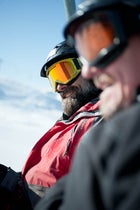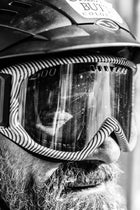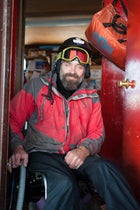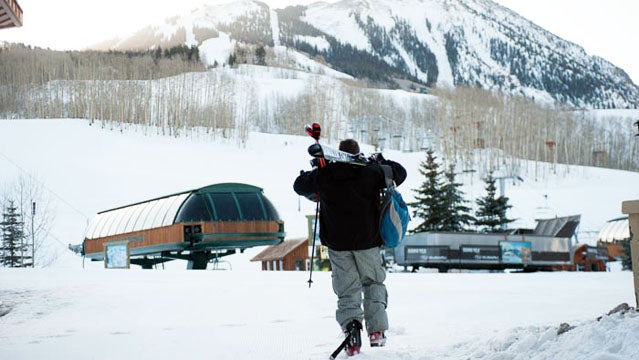Shaun White. Franz Klammer. Ingemar Stenmark. Tanner Hall. Larry Olmsted.
The Snow Report
The latest snow, ski, and winter sports stories from ���ϳԹ���. Larry Olmsted and Jim Harlan ride to another run.
Larry Olmsted and Jim Harlan ride to another run. Crested Butte ski patrol dispatcher Jim Harlan.
Crested Butte ski patrol dispatcher Jim Harlan. Crested Butte ski patrol dispatcher Jim Harlan.
Crested Butte ski patrol dispatcher Jim Harlan.What do these names have in common? And who the hell is Larry Olmsted? They are five of the many people who have skied or snowboarded their way into the pages of the world’s most famous record book. I am Larry Olmsted, and I currently hold a Guinness World Record for downhill skiing—a record you could break this winter.
That’s right, you could be immortalized as that guy (or gal) who broke a Guinness World Record in downhill skiing. You would get a cool certificate. Glory. Maybe even free beers at your local après haunt.
Breaking my record is not only possible, it not even that difficult. Depending on your skiing ability, you might not even have to train for it. I know this is true because I set the record back in March and I’m merely a solid advanced skier. Plus, I might know more about Guinness World Records than anybody else, as I literally wrote the book on the book, (Harper Collins, 2008). Having broken or set records for golf, marathon poker playing, and skiing, I’m not just telling you it can be done, I’m daring you. Double dog daring you. Break my record, please. Honestly, it’s not me you have to worry about in your pursuit of fame—it’s everyone else reading this story.
My record is for the “Most Pistes Skied in 8 Hours.” Translated from Guinness-speak, this means: the most different (repeats of the same run do not count) trails skied in their entirety (you can’t drop in halfway down) in under eight hours. The trails have to appear on the resort map or master plan—you can’t make them up. Length or difficulty doesn’t matter. They can be long or short, green or double black, but they have to be different and skied completely. The magic number is 64, the total pistes I skied alongside my co-record holder Jim Harlan on March 7, 2012, at Colorado’s Crested Butte resort.
This is how we did it.
First I had to pick a mountain. I live in Vermont, but chose because it’s a “skier’s mountain,” a place where passion trumps fashion. Also, knowing what I do about records I knew it would not last even a single season. In fact, I’d be disappointed in ski bums everywhere if it has not been broken and re-broken several times by spring. Because of its difficult terrain Crested Butte is hardly suited to a day of racing down as many slopes as possible. You’d probably have a relatively easy time topping 64 trails at a mountain loaded with groomed cruisers, someplace like Beaver Creek or Deer Valley—if (ahem) you like doing things the easy way.
Next, I found a ringer: Jim Harlan, the dispatcher for Crested Butte’s ski patrol. When he was a teenager, Harlan brok his neck diving into a swimming pool and became a quadriplegic but he went on to capture national and world titles in handcycling. He’s a highly talented mono skier with an intimate knowlede of Crested Butte’s trails—an especially valuable attribute when it came to setting our record.
According to Guinness’s rules, multiple trails can be skied in one descent as long as each is skied completely. Thus, three shorter runs that connect to each other offer more bang for the buck than one longer top to bottom trail. Before flying out to Colorado, I spent hours at home poring over trail maps trying to plot the most efficient game plan for the day, looking for ways to combine multiple trails while avoiding traverses or riding one lift simply to get to another. But once I connected with Harlan, he explained that there are official trails not listed on the printed resort map due to space and type-size limitations. So while my best planning effort had combined five trails in one run, top to bottom, he used the much more detailed patrol map to route a 10-run descent.
Unfortunately, when I arrived at Crested Butte in early March, the resort, like most of the rest of the country, was suffering through the worst snow year in anyone’s memory. His 10-run route went through the Byzantine maze of short, extreme trails off the North Face lift, which were all closed. Still, his knowledge proved indispensable, especially when it came to that old ski resort trick of padding trail counts by renaming a single trail partway down. Thus what’s on the map as International officially appears on the resort’s master plan and on-slope signage as Upper, Middle, and Lower International—three trails, not one.
Weather was my biggest worry. I had planned only a two-day window of opportunity as I couldn’t afford to stay in Colorado forever waiting for perfect conditions. (Ironically, a big powder day would have hurt us as piles of fluffy snow would slow us down.) I decided to pack just one pair of skis to get me through any conditions: K2’s AMP Rictor, the most versatile all-mountain ski I’ve used. There was a whole bunch of other crap to consider in the detailed planning, from camera and video equipment (Guinness has tons of documentation requirements) to food and drink on the run, all while minimizing stops.
The skiing itself went pretty smoothly except for one mishap that involved a “Thin Cover” sign and an unplanned foray into the trees. Besides that, the biggest problem, predictably, was my legs. We skied trails of every difficulty level, including lots of high-speed blue cruisers, and we skied them fast. It’d probably been since I was in high school that I skied first to last chair. Did I feel the burn? Hell yes.
The bottom line is that if you can ski faster than me or have better endurance and are willing to spend a little more time on advance planning, you can break my record. In fact, you might smash it. In better snow conditions we might have knocked off 75 runs. I think 100 is within the realm of possibility for a better, fitter skier. Ultimately the limits are available terrain and lifts. There are a finite number of lifts you can ride in eight hours no matter how good you are, and only a small number of resorts that will have 100 or more trails open.
So I’m really very curious to see how high this record can go.
BUT FIRST, SOME THINGS you should know about Guinness World Records.
In 2004 I wrote an article for Golf Magazine about trying to club my way into the Guinness book, which at the time I knew nothing about. The record I broke was the “Greatest Distance Traveled Between Two Rounds of Golf Played in the Same Day.” Teeing off in Sydney, Australia, then southern California, I put 7,496-miles behind me, beating the existing mark by nearly 2,000 miles. Take that Guinness! The story was a big hit and I was a Top 10 Play of the Day on ESPN’s “Sportscenter.”
Then my friends started asking questions, like “Does the Guinness book have anything to do with the beer?” “What are the rules?” “What do you get?” And so on. I realized that everyone knew what the Guinness World Records were, but nobody knew anything about them. So I decided to write a book. Since I had already broken an existing record and the other path to Guinness glory is to set a new record, I decided to do just that. I settled on the longest non-stop marathon casino poker playing session, which I set in 72 hours and two minutes, enduring hallucinations, swollen eyelids, and all sorts of mental issues. And yes, thanks for asking, I was again a Top 10 Play of the Day on ESPN’s “Sportscenter.” I have it TIVO’d.
I soon learned an unfortunate truth: the folks at Guinness were pretty secretive and maybe even paranoid. When I sold my book, they banned me for life from record setting. A New York Times story on my plight ran under the headline, “.” It sucked for me, but it didn’t make the Guinness story any less fascinating.
In 1954, two British executives went bird hunting, and because they were not very good shots, they changed the history of sports, publishing, and popular culture. After missing targets all day, they got into an argument over which was the fastest game bird in Europe, the grouse or golden plover, and made a gentleman’s bet (both turned out to be wrong).
One of the hunters was Sir Hugh Beaver, Knight of the British Empire, and managing director of Ireland’s Arthur Guinness & Sons, the world’s largest brewer. He consulted reference books, only to find that no one had bothered to compile the relative speeds of grouse and plovers. This led Sir Hugh to his ah-hah moment: he realized that Guinness owned or supplied countless pubs full of buzzed patrons facing similarly inane arguments over random questions. He commissioned his brewery to publish a trivia book for bars, and to Beaver’s surprise, The Guinness Book of Records proved an overnight sensation. It has reached the number one spot on the U.S. and U.K. bestseller lists every single year since without fail, for more than half a century. Today the book (sold by the brewery and renamed Guinness World Records) moves over a million copies annually in this country alone, is published in more than three dozen languages, and with somewhere north of 125,000,000 copies, is the best-selling copyrighted work in human history. By most estimates Guinness World Records is the third or fourth most widely read book ever, after the Bible, Koran, and possibly Chairman Mao’s Little Red Book.
The book became the final, authoritative answer to all sorts of odd questions, and “according to Guinness” entered the lexicon. But most importantly, it changed the importance of records and how people behaved. In many ways Guinness World Records was the precursor to both reality TV and the current craze for fracturing sports records with myriad qualifiers—first to climb Everest without oxygen, blind, left-handed, youngest, oldest, and so on. It offered a bizarre yet democratic way for people to claim their fleeting moment of fame, and led them to do amazing, amusing, and often stupid things.
There are records and then there are records, the latter belonging to folks like Neil Armstrong, Sir Edmund Hillary, Usain Bolt, and Cal Ripken. The former belong to tens of thousands of Guinness devotees who have pogo-sticked, somersaulted, and eaten their way into the book. People like Geoff Smith, who spent 147 days in a coffin six feet below a pub parking lot, breaking the record for being buried alive that had been set by—wait for it—his mother. Or Ashrita Furman, owner of more Guinness records than anyone, including distance walked while balancing a glass milk bottle on your head (81 miles). Or Adrian Hilton, who recited the complete works of Shakespeare aloud, nonstop, over five sleepless days.
Indeed, it is the Adrian Hiltons of the world that keep the book selling. This despite the fact that Guinness has long had an extremely complicated record-setting process as well as a reputation of being insensitive to its passionate fan base. It wasn’t until last year that they finally streamlined their operation and began repairing their image.
After my book came out and proved not just harmless but supportive, they reinstated me as part of their new feel-good community outreach efforts. If I was not the only person ever banned for life from Guinness World Record setting, surely I was the only one to have a ban repealed. I was back!
NOW, GETTING BACK TO my soon-to-fall record.
Guinness World Records receives over 75,000 record applications each year, and only a tiny fraction end in success. Many folks give up right away, after receiving complex guidelines, rules, and legal releases. Just the “Evidence Required” document is 18 pages of tiny, legalese print. As Christopher Darwin, great-great-grandson of the famed evolutionist and a record holder himself (for highest altitude formal dinner) put it: “If it was easy, everyone would do it. Right now there are probably people down at the pub making wild plans. But they’ll never do them.”
Don’t be those people.
There are two ways to nab a record: break an existing one or set a brand new one. Both are tricky.
Few know the actual printed Guinness book is a “best of” compendium containing far less than 10 percent of all records. This vast omission, coupled with a longtime refusal to index records online, made it impossible for would-be record breakers to determine if a record even existed. For example, you might think up a new record for smashing a piano to bits with a sledgehammer really fast. You check the latest edition of the book and, upon not finding such a record, assume it is fertile ground. Only later would you learn that this record pre-dates the moon landing by years. And even if you knew the current record for piano smashing—97 seconds last I checked—it is only weeks after your application that you would discover that for every eccentric record, Guinness has very specific rules: the piano must be smashed entirely into pieces small enough to be passed through a 10-inch ring.
Fortunately, as part of last year’s streamlining efforts, GWR added a searchable online index and Twitter handle () where you can ask about any record and get the description or suggested close alternative record. Still, the truth is that cooking up an entirely new record that Guinness deems worthy is really hard. My ski record attempt was approved only after they turned down my first offer, the most descents of the same trail in eight hours. Why? Who knows?
At the start of the process, you apply online with an explanation of what you are going to do, why it matters, how you will do it, and how it will be measured. Guinness is truly obsessed about this last point. For our ski attempt we needed live witnesses the entire time from an official sporting body, plus video, still photography, a minute by minute diary log book, and affidavits from everyone involved. All of this is a big pain in the ass, and many people have successfully “broken” records only to be turned down for imprecise documentation.
Since FIS was unlikely to come observe us, I turned to the . Shout out to Justin Fishback and Nathan Dole, the crème de la crème of the Crested Butte PSIA staff for not just helping out as witnesses but for being good sports and great company (and great après ski whiskey drinkers!). An extra special shout out to Emily McCormack of Eagle, Colorado, who served as our videographer/photographer/domestique and to her credit skied almost every run with us.
Afterwards I bundled all “required evidence,” including witness statements, video, photos, and trail maps, then mailed it off to London. The record adjudicator came back and demanded the resort’s data from my scannable lift ticket and a grooming report from our day. (Did I mention they are picky?) Finally satisfied, we received certificates suitable for framing and became part of ski history.
NOW IT’S YOUR TURN. You have eight hours to ski 65 or more unique, officially mapped trails in their entirety. But other people reading this will be aiming much higher so I wouldn’t shoot for less than 80. We went for style points and ignored common sense, making several errors that would have given us a higher tally. We don’t care. We are World Record holders. But if sheer quantity is your goal, don’t follow our example, since we violated every one of these five key rules:
1. Choose a less challenging ski resort featuring lots of groomed cruisers
The obvious picks would be Deer Valley and Beaver Creek, both known for grooming, with the majority of trails blue or green. Northstar at Tahoe offers fully 73 percent beginner and intermediate terrain, while 65 percent of Mammoth’s 150 trails and almost 70 percent of Park City Mountain Resort’s 114 trails are less advanced. The Canyons offers a stunning 182 trails, nearly 100 of which are not black.
2. Pick your mountain by trail layout and high-speed lifts
Slow lifts and long traverses are your worst enemy, so while Vail has the most trails, getting to and from certain lifts takes a lot of time. Mammoth has a whopping 14 high-speed lifts and 12 of compact Deer Valley’s 21 lifts are high-speed, a better ratio than most other big mountains. Beaver Creek has one of the best percentages of high-speed chairs, coupled with 150 trails.
3. Avoid black and double black terrain, especially moguls
We wanted to ski every type of terrain, including double black, on principle. You don’t have to. It’s more tiring.
4. Wait for ideal conditions
If you live at a big ski area this is easy.
5. Don’t waste time using the actual restroom
Enough said.
Then there are the five things we did that you’ll want to duplicate.
1. Go beyond the printed resort map
If you don’t have access to ski patrol maps, try the daily grooming report, which typically lists every single trail, including multiples such as Upper and Lower Whatever.
2. Start on top
Rules allow you to begin your eight hours atop the mountain, saving you at least one lift ride.
3. Map the day
Make a plan and start with the greatest number of trails you can combine into single lift rides. Save one trail lift ride for the end, and if you have time left, add these less efficient laps.
4. Think like a beginner
Novice runs at a base learning area count just as much as the steeps off the backside. Heck, you might even get credit for skiing off the magic carpet. And remember, it doesn’t matter how slow a chair is when it’s like a hundred feet long! Terrain parks usually count as trails too. You don’t have to jump.
5. Go big
If you are shooting for 80 trails, don’t pick a mountain with 80 trails. You rarely get 100 percent open terrain and don’t want to have to ski chutes, glades or ride T-bars to far removed trails. At bigger resorts like Steamboat, Vail, or the Canyons you can ski half the trails and still break the record.
Your first step should be to log onto and click on Set A Record. Register and follow the instructions. They will send you rules for this specific record. Follow these to the letter! They require a certain number of minutes of video to be shot during every hour of the attempt, so be redundant. I used a GoPro and the battery failed so I eked by with my MinoHD handheld.
Remember, I did everything they asked and it still wasn’t enough, so it is always better to submit extra—use a GPS that can be downloaded to a computer and send real-time mapped evidence of your entire day (I meant to but forgot to turn on the GPS). Witnesses are the most important thing: they don’t absolutely have to be “officials” but this is preferred, so hire an instructor or two for the day. If you go another route use several witnesses, the more the merrier, but they have to witness the entire thing, something hard to do unless they are skiing with you.
Good luck and pray for snow!


